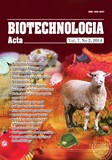ISSN 2410-7751 (Print)
ISSN 2410-776X (Online)

"Biotechnologia Acta" v. 7, no 2, 2014
Р. 46-53, Bibliography 11, Ukrainian.
Universal Decimal classification: 577(112+25+354.9)+57(085.2+086.2)
https://doi.org/10.15407/biotech7.02.046
OBTAINING AND CHARACTERIZATION OF RECOMBINANT FLUORESCENT DERIVATIVES OF SOLUBLE HUMAN HB-EGF
N. V. Korotkevich, A. Ju. Labyntsev, D. V. Kolibo, S. V. Komisarenko
Palladin Institute of Biochemistry of the National Academy of Sciences of Ukraine, Kyiv
Heparin-binding EGF-like growth factor (HB-EGF) belongs to the epidermal growth factor receptor family and is synthesized as a transmembrane precursor proHB-EGF. Binding of sHB-EGF with receptors EGFR and HER-4 results in formation of ligand-receptor complexes and activation of signaling pathways and thereby promotes survival, proliferation and migration of cells.
The aim of the study was to obtain the recombinant fluorescent derivatives of full-length soluble sHB-EGF – mCherry-sHB-EGF and truncated sHB-EGF?84-106 (without heparin-binding domain) – mCherry-sHB-EGF?84-106. The recombinant fluorescent derivatives may be used to investigate the sHB-EGF binding with receptors EGFR and HER-4, intracellular transportation of ligand-receptor complexes and the role of sHB-EGF heparin-binding domain in sHB-EGF biological activity.
It was shown the ability of both fluorescent derivatives specifically bind to EGFR, to internalize in receptor-mediated pathway and to enhance the proliferation of 3T3 cells. Absence of heparin-binding domain in structure of mCherry-sHB-EGF?84-106 significantly did not effect on its ability to bind with receptor, but decreased twice its mitogenic activity. Thus, obtained fluorescent derivatives of sHB-EGF could be a convenient tool for investigation of molecular mechanisms of sHB-EGF biological activity and role of heparin-binding domain in these processes.
Key words: heparin-binding EGF-like growth factor (HB-EGF), epidermal growth factor receptor.
© Palladin Institute of Biochemistry of the National Academy of Sciences of Ukraine, 2014
References
1. Higashiyama S., Abraham J. A., Miller J., Fiddes J. C., Klagsbrun M. A heparin-binding growth factor secreted by macrophage-like cells that is related to EGF. Science. 1991, 251(251), 936–939.
https://doi.org/10.1126/science.1840698
2. Higashiyama S., Nanba D. ADAM-mediated ectodomain shedding of HB-EGF in receptor crosstalk. Biochim Biophys Acta. 2005, 1751(1), 110–117.
https://doi.org/10.1016/j.bbapap.2004.11.009
3. Roepstorff K., Grandal M. V., Henriksen L., Knudsen S. L., Lerdrup M., Gr?vdal L., Willumsen B. M., van Deurs B. Differential effects of EGFR ligands on endocytic sorting of the receptor. Traffic. 2009, 10(8), 1115–1127.
https://doi.org/10.1111/j.1600-0854.2009.00943.x
4. Lin S.Y., Makino K., Xia W., Matin A., Wen Y., Kwong K. Y., Bourguignon L., Hung M. C. Nuclear localization of EGF receptor and its potential new role as a transcription factor. Nat Cell Biol. 2001, 3(9), 802–808.
https://doi.org/10.1038/ncb0901-802
5. Kim J., Adam R. M., Freeman M. R. Trafficking of nuclear heparin-Binding epidermal growth factor–like growth factor into an epidermal growth factor receptor–dependent autocrine loop in response to oxidative stress. Cancer Res. 2005, 65(18), 8242–8249.
https://doi.org/10.1158/0008-5472.CAN-05-0942
6. Korotkevych N. V., Kolybo D. V., Labyntsev А. Ju., Romaniuk S. І., Komisarenko S. V. Obtaining of recombinant human heparinbinding EGF-like growth factor and perspectives of its application in biotechnology. Biotekhnolohiia. 2010, 5(4), 44–54. (In Ukrainian).
7. Korotkevych N. V., Labyntsev A. Ju., Kaberniuk A. A., Oliinyk O. S., Romaniuk S. I., Kolybo D. V., Komisarenko S. V. Cytotoxicity of the B subunit of diphtheria toxin to human histocytic lymphoma U937. Ukr. Biokhim. Zh. 2009, 81(4), 69–80. (In Ukrainian).
8. Dower W. J., Miller J. F., Ragsdale C. W. High efficiency transformation of E. coli by high voltage electroporation. Nucleic Acids Res. 1988, 16(13), 6127–6145.
https://doi.org/10.1093/nar/16.13.6127
9. Sch?gger H., von Jagow G. Tricinesodium dodecyl sulfate-polyacrylamide gel electrophoresis for the separation of proteins in the range from 1 to 100 kDa. Anal. Biochem. 1987, 166(2), 368–379.
https://doi.org/10.1016/0003-2697(87)90587-2
10. Harlow E., Lane D. Antibodies: a laboratory manual. N. Y.: Cold Spring Harbor Laboratory. 1988, 726 p.
11. Higashiyama S., Lau K. E., Besner G. A., Abraham J., Klagsbrun M. Structure of heparin-binding EGF-like growth factor. Multiple forms, primary structure, and glycosylation of the mature protein. J. Biol. Chem. 1992, 267(9), 6205–6212.

